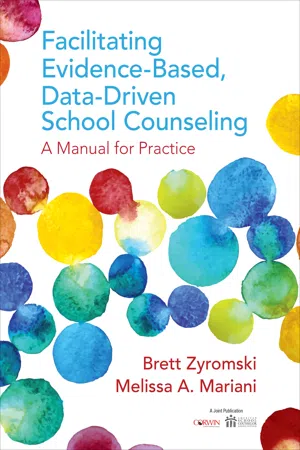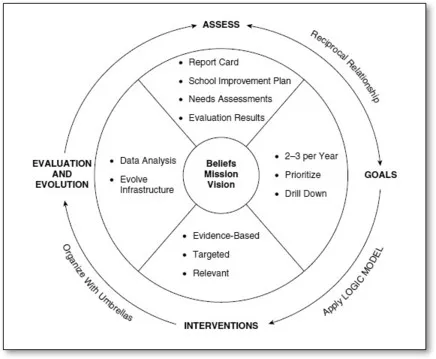
Facilitating Evidence-Based, Data-Driven School Counseling
A Manual for Practice
- 176 pages
- English
- ePUB (mobile friendly)
- Available on iOS & Android
Facilitating Evidence-Based, Data-Driven School Counseling
A Manual for Practice
About this book
Counselors make a difference—and now you can prove it.
As students' needs change, dedicated school counselors have been evolving their practice. You see the results every day, on the faces of the at-risk students you serve. To meet accountability standards, though, you need more than faces: You need data the number-crunchers can understand.
With this user-friendly manual, make the shift to evidence-based practices and interventions in a data-driven, comprehensive school counseling program based on ASCA's national model—while keeping the personal nature of your work intact. The book includes
- Visual guides and checklists for every step of the process
- Examples of successful counseling program evolution
- Guidance on developing and submitting a successful Recognized ASCA Model Program (RAMP) application
- Supporting documents in an online resource center
Ensure that school counseling is recognized as an essential part of school improvement and students' academic success by using this unique and innovative model.
"Provides realistic examples, clear templates, and step-by-step strategies that ease the stress of what is often seen as an overwhelming process."Judith Bookhamer, Executive Director
Pennsylvania School Counselors Association
"Provides succinct and straight-forward tools to assist school counselors in marrying data-based decision-making practices with evidence-based counseling to create successful outcomes. This is a school counselor?s dream!"
Franciene Sabens, Professional School Counselor
Chester High School, Chester, IL
"Starting with creating mission and vision statements and ending with advocacy efforts, the authors outline specific ways school counselors can integrate evidence-based interventions in their programming to positively impact student outcomes."
Jennifer Betters-Bubon, Assistant Professor
University of Wisconsin-Whitewater
Frequently asked questions
- Essential is ideal for learners and professionals who enjoy exploring a wide range of subjects. Access the Essential Library with 800,000+ trusted titles and best-sellers across business, personal growth, and the humanities. Includes unlimited reading time and Standard Read Aloud voice.
- Complete: Perfect for advanced learners and researchers needing full, unrestricted access. Unlock 1.4M+ books across hundreds of subjects, including academic and specialized titles. The Complete Plan also includes advanced features like Premium Read Aloud and Research Assistant.
Please note we cannot support devices running on iOS 13 and Android 7 or earlier. Learn more about using the app.
Information
1 The Process

After a differentiated delivery system is in place, developing the mechanisms that support planning, management, and professional decision-making may become more salient factors because these mechanisms increase the effectiveness of the services actually delivered. If this interpretation is correct, it has implications for program development. In implementing an ASCA National Model program, the most effective approach may be to focus first on helping counselors develop a differentiated delivery system, then focus on developing the mechanisms (e.g., mission statement, advisory council, decision-making processes) that guide the management of these activities. (2012, p. 147)
Purpose
- Assessing the current school environment (see Chapter 2) as it relates to school-defined goals (as detailed in school improvement plans), as it relates to student equity gaps (as detailed in school report cards or other achievement data or achievement-related data), and as it relates to connecting student-identified needs and student-identified barriers to success with the data previously mentioned. This data is needed both for decision-making and for designing an appropriate differentiated delivery system.
- Setting school counseling program goals (see Chapter 3) using the data collected in Step 1. An important aspect of setting school counseling program goals is using the data collected from Step 1 to prioritize how to spend your time, targeting specific needs, which will (hopefully) result in specific outcomes. Steps 1 and 2, together, encapsulate a data-driven decision-making model, and the relationship between Steps 1 and 2 is reciprocal. That is, each step co-occurs, and one often informs the other. A logic model will be used to explain this process more clearly in Chapter 3.
- School counseling program beliefs, mission, and vision define the direction of the program (see Chapter 4).
- Choosing interventions strategically (evidence-based whenever possible) to meet student-identified needs (the outcomes), which consequently alter data prioritized by adults in schools (achievement data, achievement-related data, and competency-related data) (see Chapter 5). This step provides developmentally appropriate evidence-based interventions to meet students’ needs. Again, the logic model is used to explain this process clearly.
- Evaluating specific interventions (Hatch [2014] refers to this as the flashlight approach) to connect the intervention with outcomes. Strategies for organizing interventions using visual umbrellas and creating Excel spreadsheets for collecting data will be presented in Chapter 6. Further, strategies for evolving programs based on intervention evaluation will conclude this chapter.
- Chapter 7 concludes the manual by connecting the evolution of the interventions to the first step of the manual—how to assess the school environment, how to evolve program goals, and how to refine the mission and vision of an evidence-based, data-driven comprehensive school counseling program.

The ASCA National Model and Evidence-Based, Data-Driven Comprehensive School Counseling
Definitions
- American School Counselor Association (ASCA) National Model. This refers to the third edition of a model that has evolved to provide “components of a comprehensive school counseling program” (American School Counselor Association, 2012, p. xii). The focus is on improving student achievement.
- Recognized Recognized ASCA (American School Counselor Association) Model Program (RAMP). This is a designation for schools that have earned recognition from the ASCA for having a program that meets twelve components illustrating that the school counseling program aligns with the ASCA National Model. Schools must apply for the designation and submit a self-study indicating how their programs meet the twelve components detailed in the RAMP Rubric (American School Counselor Association, 2014).
- Data-Driven Decision-Making. This is “a school improvement approach that uses quantitative data analysis techniques to help describe problems and to direct activities and resource allocations” (Dimmitt, Carey, & Hatch, 2007, p. 17).
- Evidence-Based Interventions. Within this text, the term evidence-based interventions will be interchangeable with the term research-based interventions, which “refer to interventions that have evidence of effectiveness from high-quality outcome research” (Dimmitt, Carey, & Hatch, 2007, p. 49).
- Comprehensive School Counseling Program. “Comprehensive in scope, preventative in design and developmental in nature,” these school counseling programs focus on meeting the needs of all students through academic, career, and social/emotional programming and interventions (American School Counseling Association, 2012, p. xii).
- Logic Model. This is a visual representation of a process that represents the relationship between variables or factors that lead to some outcome. It can often be a diagram or flow chart.
- Umbrellas. Umbrellas are program organization tools. They are visual representations of interventions targeting issues identified using data. The interventions are organized under the three domains represented in a comprehensive school counseling program: (a) academic, (b) career, and (c) social/emotional.
- Measurable. Quite simply, for the purposes of planning assessment of...
Table of contents
- Cover
- Half Title
- Title Page
- Copyright Page
- Contents
- Preface
- Acknowledgments
- About the Authors
- 1 The Process
- 2 Assessing the Situation
- 3 Setting Goals
- 4 Beliefs, Mission, and Vision
- 5 Interventions
- 6 Evaluation and Evolution
- 7 Disseminating Results and Sustaining the Program
- Appendix A: Belief Statement Examples
- Appendix B: Mission Statement Examples
- Appendix C: Needs Assessments
- References
- Index
- Publisher Note